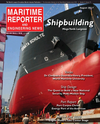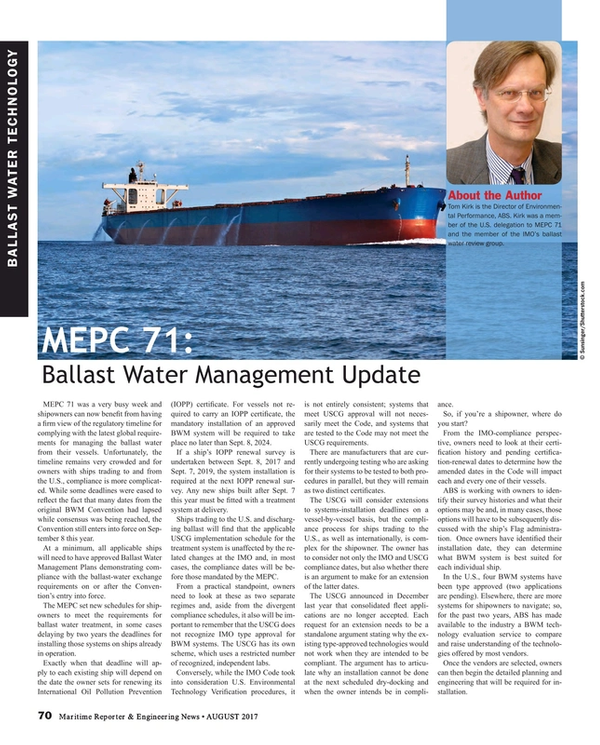Marine Environment Protection Committee (MEPC) 71 was a very busy week and ship owners can now benefit from having a firm view of the regulatory timeline for complying with the latest global require-ments for managing the ballast water from their vessels. Unfortunately, the timeline remains very crowded and for owners with ships trading to and from the U.S., compliance is more complicated. While some deadlines were eased to reflect the fact that many dates from the original BWM Convention had lapsed while consensus was being reached, the Convention still enters into force on September 8 this year.
At a minimum, all applicable ships will need to have approved Ballast Water Management Plans demonstrating compliance with the ballast-water exchange requirements on or after the Convention’s entry into force.
The MEPC set new schedules for ship owners to meet the requirements for ballast water treatment, in some cases delaying by two years the deadlines for installing those systems on ships already in operation.
Exactly when that deadline will apply to each existing ship will depend on the date the owner sets for renewing its International Oil Pollution Prevention (IOPP) certificate. For vessels not required to carry an IOPP certificate, the mandatory installation of an approved BWM system will be required to take place no later than September 8, 2024.
If a ship’s IOPP renewal survey is undertaken between September 8, 2017 and Sept. 7, 2019, the system installation is required at the next IOPP renewal survey. Any new ships built after September 7 this year must be fitted with a treatment system at delivery.
Ships trading to the U.S. and discharging ballast will find that the applicable U.S. Coast Guard (USCG) implementation schedule for the treatment system is unaffected by the related changes at the International Maritime Organization (IMO) and, in most cases, the compliance dates will be before those mandated by the MEPC.
From a practical standpoint, owners need to look at these as two separate regimes and, aside from the divergent compliance schedules, it also will be important to remember that the USCG does not recognize IMO type approval for BWM systems. The USCG has its own scheme, which uses a restricted number of recognized, independent labs.
Conversely, while the IMO Code took into consideration U.S. Environmental Technology Verification procedures, it is not entirely consistent; systems that meet USCG approval will not necessarily meet the Code, and systems that are tested to the Code may not meet the USCG requirements.
There are manufacturers that are currently undergoing testing who are asking for their systems to be tested to both procedures in parallel, but they will remain as two distinct certificates.
The USCG will consider extensions to systems-installation deadlines on a vessel-by-vessel basis, but the compliance process for ships trading to the U.S., as well as internationally, is complex for the ship owner. The owner has to consider not only the IMO and USCG compliance dates, but also whether there is an argument to make for an extension of the latter dates.
The USCG announced in December last year that consolidated fleet applications are no longer accepted. Each request for an extension needs to be a standalone argument stating why the existing type-approved technologies would not work when they are intended to be compliant. The argument has to articulate why an installation cannot be done at the next scheduled dry-docking and when the owner intends be in compliance.
So, if you’re a ship owner, where do you start?
From the IMO-compliance perspective, owners need to look at their certification history and pending certification-renewal dates to determine how the amended dates in the Code will impact each and every one of their vessels.
ABS is working with owners to identify their survey histories and what their options may be and, in many cases, those options will have to be subsequently discussed with the ship’s Flag administration. Once owners have identified their installation date, they can determine what BWM system is best suited for each individual ship.
In the U.S., four BWM systems have been type approved (two applications are pending). Elsewhere, there are more systems for ship owners to navigate; so, for the past two years, ABS has made available to the industry a BWM technology evaluation service to compare and raise understanding of the technologies offered by most vendors.
Once the vendors are selected, owners can then begin the detailed planning and engineering that will be required for installation.
The Author
Tom Kirk is the Director of Environmental Performance, ABS. Kirk was a member of the U.S. delegation to MEPC 71 and the member of the IMO’s ballast water review group.



